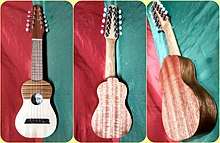Chillador
|
A chillador of the steel-strung variety, with 12 strings in 5 courses | |
| String instrument | |
|---|---|
| Hornbostel–Sachs classification | 321.321-5 |
| Developed | Early 18th century (perhaps earlier) |
| Related instruments | |
| Charango, Walaychu Ronroco. | |
The name chillador can refer either to two related types of charango. The First type, simple called chillador is a type of charango which has a flat back and is usually steel-strung. It exists in both 10-and 12-string forms. When strung with 10-strings (in 5 courses) it is tuned the same as a charango. With 12 strings, courses 2 and 4 are triple-strung, and the (re-entrant) tuning is more like that of a charangone or ronroco in Argentine tuning.[1] The chillador charango is a standardly-tuned charango but with a body built from bent sides and a flat back like a (smaller) guitar [2] [3],
Chillador or Steel-strung type
A chillador is a very small guitar-shaped fretted stringed instrument, usually with 10, 12, or 14 metal strings, in paired or tripled courses. It is played in southern Peru and northern Bolivia. The chillador has 5 courses like its cousin, the charango, and has a similar tuning to the charango[4]. The chillador is a common instrument of estudiantina ensembles[5], and is typically strummed rapidly, rather than plucked. There are several characteristics that separate a chillador from a charango: The chillador has a smaller scale length(31cm) than a charango(37cm)[6]; the chillador typically has 12 or 14 metal strings while the charango has 10 strings which are typically nylon; and the chillador has a flat back with laminated wood sides like a guitar, while the charango usually has a one-piece carved wood back or uses an armadillo shell. The chillador is an essential instrument of Kajelo music.

Chillador charango
The chillador charango is tuned like a standard charango with 10 nylon strings in 5 courses, but it is built differently, with bent sides and a flat back like a guitar or ukulele. It is often deeper than a ukulele, in order to get a similar sound as the standard carved charango. [7]
References
- ↑ "Charangoperu.com :: El portal del Charango Peruano". Retrieved 6 May 2015.
- ↑ http://www.atlasofpluckedinstruments.com/south_america.htm#bolivia South America ATLAS of Plucked Instruments
- ↑ https://stringedinstrumentdatabase.aornis.com/c.htm The Stringed Instrument Database: C
- ↑ "Ficha del Charango". pacoweb.net. Retrieved 2018-01-23.
- ↑ Ponce Valdivia, Omar (2009). "Omar Percy Ponce Valdivia. De charango a chillador. Confluencias musicales en la estudiantina altiplánica". Revista musical chilena. 63 (212): 143–144. doi:10.4067/S0716-27902009000200017. ISSN 0716-2790.
- ↑ "Chillador". pacoweb.net. Retrieved 2018-01-23.
- ↑ https://sites.google.com/site/norbertodeleonluthier/home/el-charango/tipos-de-charango/el-waylacho-o-chillador Taller de lutheria: chillador